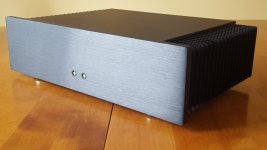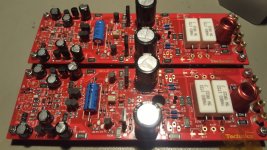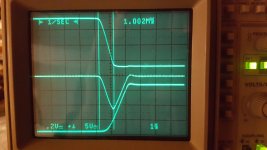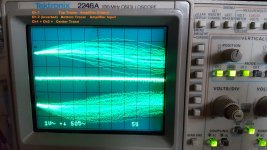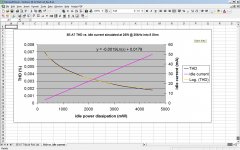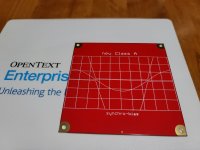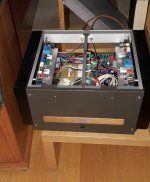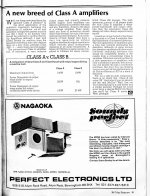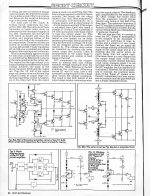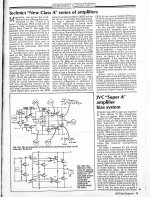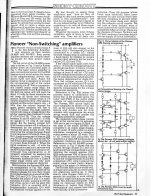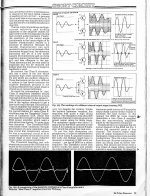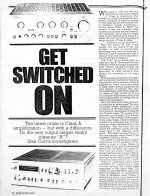Well, for now I am contemplating the idea of building a Technics New Class A clone. I was wondering if there would be any interest by this community on this and if people would want one and get a kit. I am thinking to do mono blocks of 250W each and have them a little bit pimped up, Technics style of course 😀 This will likely not going to be a budget project.
I am so fascinated by the slick circuit design and ingenuity of the Technics designers and perhaps devote the clone to them in deep respect.
I am so fascinated by the slick circuit design and ingenuity of the Technics designers and perhaps devote the clone to them in deep respect.
Having an SE-A3 myself I can just agree that Technics made a huge statement 40 years ago. Still many years later they have not done anything like it.
Not in terms of sound quality, nor measurement spec.
I have the schematics and I also have some components for a future clone.
The rare 2-OA90-H (matched pair) diodes or 2OA90 or sometimes 20A90 are hard to get. And is necessary for the bias control. (i do have original matched pairs if someone is interested by the way) . The circuit is very complicated with no capacitors in the signal pat nor in the feedback. Extremely low open loop distortion, and the TIM distortion is not measureble att that time. Most important however is the sound.
Building a 4 layer board with surface mounted components, and some really good OP-amps the construction could be modernized. Maybe even better. Too big task for me, thats why Its still on the planning/dreaming stage still.
Not in terms of sound quality, nor measurement spec.
I have the schematics and I also have some components for a future clone.
The rare 2-OA90-H (matched pair) diodes or 2OA90 or sometimes 20A90 are hard to get. And is necessary for the bias control. (i do have original matched pairs if someone is interested by the way) . The circuit is very complicated with no capacitors in the signal pat nor in the feedback. Extremely low open loop distortion, and the TIM distortion is not measureble att that time. Most important however is the sound.
Building a 4 layer board with surface mounted components, and some really good OP-amps the construction could be modernized. Maybe even better. Too big task for me, thats why Its still on the planning/dreaming stage still.
Last edited:
the idea of building a Technics New Class A clone
Why? Those things were midfi at best. Empty specsmanship.
Could you be more specific regarding the construction?
How would you improve SE-A3 as an example?
🙄
How would you improve SE-A3 as an example?
🙄
Wow, this is a real old thread of mine. Eventually I just went ahead and build a replica of a SE-A7 and SE-A5 using MT200 transistors and other Japanese made goodies for myself and a friend - for the fun of it. 4 Layers were not needed, I managed to get away with a two layer boards having only a single routing layer.
Initial simulation results were encouraging.
I did not use the old paired diodes as they are virtually impossible to get. But there is a modern replacement for these. These diodes are dirt cheap so I bought some bulk and found many decent matches easily and still have plenty of life time supply.
Well, I would not necessarily say the circuit is very complicated, unless you are referring to the SE-A100, which is a different animal all together and a bit more complex than the usual but in my books it is the cream de la cream what Technics had to offer to date. (and yes, I am working on a replica of this one too, but this is a longer project ongoing)
Today Technics does some abysmal stuff with 0.5% THD and call it a new high performance standard. - really sad story. -
They did things a few magnitudes better in the 80s than what they come up with today. I guess all real engineers retired and today's wannabe engineers who think they know it all have not even gotten a faint clue. But at least they use GAN technology - so kool.
Yes, the sound is the most important feature. My replicas, as far as I can measure and tell by A/B comparison with my well kept SE-A5 is the same. Massive bass, well defined mids and brilliantly crystal clear highs. Pretty much describes the SE-A sound on a decent set of speakers like, DSS-9, Tekton or Dirty Omen Weekends and with a decent sound source of course.
One obvious observation, the amplifier remains remarkably cool during operation while providing effectively Class A sound.
My friend went a little further and did extensive A/B listening comparisons, which I unfortunately could not attend, and he found models by
Bryston
Denon
AudioNet and
Emotiva
inferior in direct comparison with the A5 replica. His comments we mostly complaints that the Bass is sounded much different with the other amplifiers, not as pleasant as with the A5 replica. Which I find weird, since some models sport much more impressive DF figures than the A5.
Since he is a much more picky fellow than myself, I do take his word for it.😀
My A7 replica, uses mostly SMD components, but all power stuff is still TH. I also used this opportunity to cleanup the original wire-mess that one can find on the old Technics. Mine only has one cable and that is used for the input signal, everything else is a direct board to board connection. Turned out reasonably clean I'd say.
Cheers
Initial simulation results were encouraging.
I did not use the old paired diodes as they are virtually impossible to get. But there is a modern replacement for these. These diodes are dirt cheap so I bought some bulk and found many decent matches easily and still have plenty of life time supply.
Well, I would not necessarily say the circuit is very complicated, unless you are referring to the SE-A100, which is a different animal all together and a bit more complex than the usual but in my books it is the cream de la cream what Technics had to offer to date. (and yes, I am working on a replica of this one too, but this is a longer project ongoing)
Today Technics does some abysmal stuff with 0.5% THD and call it a new high performance standard. - really sad story. -
They did things a few magnitudes better in the 80s than what they come up with today. I guess all real engineers retired and today's wannabe engineers who think they know it all have not even gotten a faint clue. But at least they use GAN technology - so kool.
Yes, the sound is the most important feature. My replicas, as far as I can measure and tell by A/B comparison with my well kept SE-A5 is the same. Massive bass, well defined mids and brilliantly crystal clear highs. Pretty much describes the SE-A sound on a decent set of speakers like, DSS-9, Tekton or Dirty Omen Weekends and with a decent sound source of course.
One obvious observation, the amplifier remains remarkably cool during operation while providing effectively Class A sound.
My friend went a little further and did extensive A/B listening comparisons, which I unfortunately could not attend, and he found models by
Bryston
Denon
AudioNet and
Emotiva
inferior in direct comparison with the A5 replica. His comments we mostly complaints that the Bass is sounded much different with the other amplifiers, not as pleasant as with the A5 replica. Which I find weird, since some models sport much more impressive DF figures than the A5.
Since he is a much more picky fellow than myself, I do take his word for it.😀
My A7 replica, uses mostly SMD components, but all power stuff is still TH. I also used this opportunity to cleanup the original wire-mess that one can find on the old Technics. Mine only has one cable and that is used for the input signal, everything else is a direct board to board connection. Turned out reasonably clean I'd say.
Cheers
Having an SE-A3 myself I can just agree that Technics made a huge statement 40 years ago. Still many years later they have not done anything like it.
Not in terms of sound quality, nor measurement spec.
I have the schematics and I also have some components for a future clone.
The rare 2-OA90-H (matched pair) diodes or 2OA90 or sometimes 20A90 are hard to get. And is necessary for the bias control. (i do have original matched pairs if someone is interested by the way) . The circuit is very complicated with no capacitors in the signal pat nor in the feedback. Extremely low open loop distortion, and the TIM distortion is not measureble att that time. Most important however is the sound.
Building a 4 layer board with surface mounted components, and some really good OP-amps the construction could be modernized. Maybe even better. Too big task for me, thats why Its still on the planning/dreaming stage still.
Attachments
Why? Those things were midfi at best. Empty specsmanship.
I didn't have a chance to hear technics class A. I heard SE-A7 and it sounds great. Exactly as the guys above described.
I have over 100 of those matched diodes by the way. The rare 2-OA90-H (matched pair) diodes. for the cost of a dollar each...
Hi Kct and All,
My NS OPS utilises the same kind of bias clamping mechanism that Technics amplifiers do.
The result is excellent - me and Jeff have got a series of amplifiers (modular design) based on it.
Just thought my experience may be of interest 😉
Cheers,
Valery
My NS OPS utilises the same kind of bias clamping mechanism that Technics amplifiers do.
The result is excellent - me and Jeff have got a series of amplifiers (modular design) based on it.
Just thought my experience may be of interest 😉
Cheers,
Valery
Hi Vzaichenko,
yes, I am following your work with interest, absolutely exceptional work I might add. Thanks for pointing out and highlighting your work on that end. Initially when it crossed my mind to build a Technics clone, I was not aware of your work at the time. So I ended up replicating the original Technics design with modern components and with a few minor tweaks. As you might have seen my 5 channel A5 and my stereo A7 Tribute replica worked out ok'ish. Both sound identical and very pleasant to me, just like the originals. I am now taking a stab at the A100, just for the fun of it. I am thinking relaxing the power spec. down to rated 150W @ 8 Ohm. I do like the concept of Class A + Class B a lot and want to try it out. I must say, while studying the old designs I realized a few non obvious tricks of the trade - the Aha effect is well worth it. To bad most of it is forgotten and most of today's designers think jacking up idle current into Class A territory fixes crossover distortion - (very) little do they know.
Did I mention, the original A100 is a real treat, audible so as optically. 😀
However, what I don't get is, how can unmeasurably low intermodulation possibly be -Empty specsmanship-.
Perhaps analog_sa could be a little bit more specific and substantiate his claim in this regard.
yes, I am following your work with interest, absolutely exceptional work I might add. Thanks for pointing out and highlighting your work on that end. Initially when it crossed my mind to build a Technics clone, I was not aware of your work at the time. So I ended up replicating the original Technics design with modern components and with a few minor tweaks. As you might have seen my 5 channel A5 and my stereo A7 Tribute replica worked out ok'ish. Both sound identical and very pleasant to me, just like the originals. I am now taking a stab at the A100, just for the fun of it. I am thinking relaxing the power spec. down to rated 150W @ 8 Ohm. I do like the concept of Class A + Class B a lot and want to try it out. I must say, while studying the old designs I realized a few non obvious tricks of the trade - the Aha effect is well worth it. To bad most of it is forgotten and most of today's designers think jacking up idle current into Class A territory fixes crossover distortion - (very) little do they know.
Did I mention, the original A100 is a real treat, audible so as optically. 😀
However, what I don't get is, how can unmeasurably low intermodulation possibly be -Empty specsmanship-.
Perhaps analog_sa could be a little bit more specific and substantiate his claim in this regard.
I do like the concept of Class A + Class B a lot and want to try it out.
This is my Class A + Class B amp playing. 😀
Attachments
Last edited:
Hi kct, first off I think it's awesome you cloned an SE-A7. I own one and agree with all the comments made on it. I was curious, if you replicated the twin transformer power supply. I can't find any info on the advantages/disadvantages of such an arrangement. But I would think Technics made this decision for a reason.
Hi thirdicomplex,
I do not use classic transformers for my clone, I use a 300W SMPS suitable for audio.
I believe Technics emphasized a slim overall form factor of the SE-A7 to make a statement and get heads turned. e.g. attention catcher
They had these unusually flat custom transformers and also used heat pipes for heatsinking the power transistors to achieve this slim unit form factor. Very innovative at the time, I'd say.
I do not use classic transformers for my clone, I use a 300W SMPS suitable for audio.
I believe Technics emphasized a slim overall form factor of the SE-A7 to make a statement and get heads turned. e.g. attention catcher
They had these unusually flat custom transformers and also used heat pipes for heatsinking the power transistors to achieve this slim unit form factor. Very innovative at the time, I'd say.
Ah I see, you used SMPS's. What I was referring to was, not the slim design of the transformers but, that they used a separate transformer for each rail. One transformer for (+) and one for (-). This is not an arrangement I've seen used elsewhere(other than DIY'ers trying to using parts they already have.) Technics could have just as easily designed the transformers for a dual mono arrangement. Or made one large transformer for all rails. I was curious about this aspect of their design
Hi thirdicomplex,
I can not really answer that, but to speculate why. I think they cared mostly for the form factor of the product. Perhaps the space saving worked out better having only one rail winding per transformer. Perhaps they used transformer cores that were designed for a different application that were available at the time so they used them. I think they pushed the design limits on the transformer as well as with the heatsinking all the way to the edge on the A7. I believe there is also a circuit in the A7 that is thermal sensitive and it reduces the signal amplitude to prevent a thermal over load of the transformers.
I can not really answer that, but to speculate why. I think they cared mostly for the form factor of the product. Perhaps the space saving worked out better having only one rail winding per transformer. Perhaps they used transformer cores that were designed for a different application that were available at the time so they used them. I think they pushed the design limits on the transformer as well as with the heatsinking all the way to the edge on the A7. I believe there is also a circuit in the A7 that is thermal sensitive and it reduces the signal amplitude to prevent a thermal over load of the transformers.
I have a copy of an old article on the subject from the 70's:
Attachments
- Home
- Amplifiers
- Solid State
- Technics Clone New Class A
